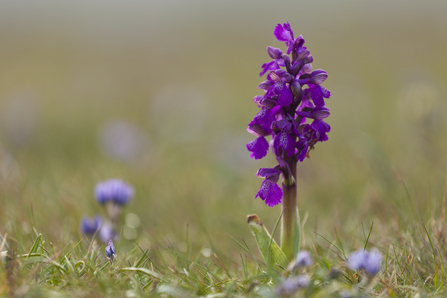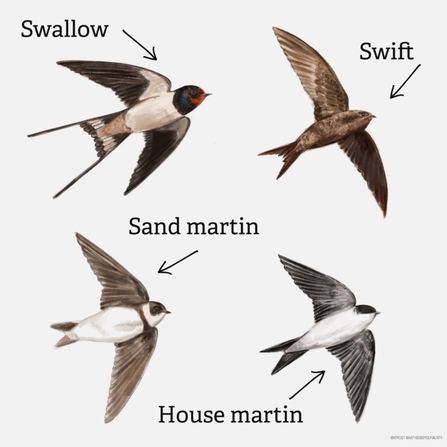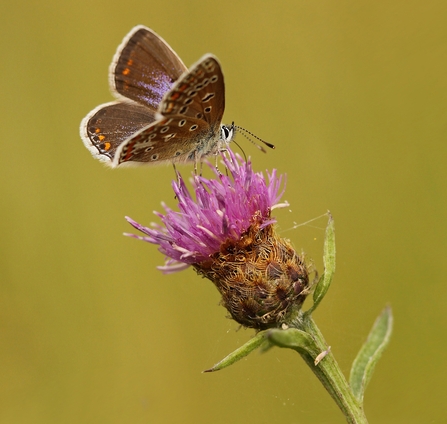The warm dry weather has continued, with still little or no rain recorded since mid-March. It has already been declared the driest spring for a century. As a result, a lot of nature’s May activity started in April, and at the time of writing many of May’s flowers are already past their best. The impressive and growing number of green-winged orchids at New Buckenham Common were on the wane before the months end, with prolonged dry weather often leaving the flower spikes rather stunted. A great deal of work has gone into improving the scrub around the many ponds on the Common, and a new grazing regime seems to be benefitting the Common’s flora, particularly the orchids. The carpets of bluebells in Norfolk’s remaining ancient woodlands were noticeably less vibrant due to the dry weather, and ‘went over’ very quickly too.

Green-winged orchid (credit: Mark Hamblin)
The deeper roots of the horse-chestnut trees ensured they still provided their large luminous green leaves. They remain young and fresh for only a short time in the UK now, this is due to the arrival in recent years of the horse-chestnut leaf-miner moth. 18th century landscape gardeners originally brought over the horse-chestnut from the Balkans, minus the moth. But, after a chase of several hundred years, the moth finally caught up with the tree. The leaf-miner caterpillars map the leaves with wiggly brown scars, so they look almost dead by August. However, the tree seems unharmed, and we are still ensured each May the pink and white pyramid flowers, standing like candles on each branch.
Swifts, one of the last migrant birds to arrive, were at least a fortnight early. They scream in a choreographed chase around our town and village roofs, even Norwich city centre has the privilege of swifts. Across our county, even in the most urban of settings, the swifts screams are joined by the rich May song of blackbirds, especially in the evening. Its fluid sounding tune is full of rich fluting notes, followed by tired whispers and confident pauses. May is full of wonderful sounds, but one of its most delightful sights is a meadow hosting hordes of buttercups in full flower. Their long gangly stems are tossed about by the slightest summer breeze, allowing the glossy yellow petals to glisten in the May sunshine.

How to tell the difference between swallow, swift, sand martin, house martin.
Not unsurprisingly, birds were of major interest on NWT reserves during May. The attractive garganey ducks were present at Hickling Broad and Marshes. A relatively rare breeding bird in the UK, the Norfolk Broads provides a stronghold for the species. It is the only UK duck that winters to our south in southern Europe and Africa, then migrates north to us in summer. Norfolk saw decent numbers of black tern moving through, with 12 counted from the visitor centre at Ranworth Broad on the first day of May. Continuing spring migration saw good numbers of wood sandpiper and Temminck’s stints across several of our coastal and Broadland reserves. Cley Marshes recorded 10+ Temminck’s, plus a bee-eater and a grey-headed wagtail. A booted eagle travelled around the east of the county, showing up for a couple of days at Martham Broad. The most significant of the unusual birds of prey this spring was the influx of red-footed falcons. The species breeds in the open steppe-like country of eastern Europe and Russia, and it often makes the odd appearance here during autumn migration. This spring over fifty birds were seen across the UK. Hickling can be a fairly regular stop-off in autumn for one, but this spring the reserve counted up to three birds across the site. Just across the border, Suffolk Wildlife Trust had FIVE at their Carlton Marshes reserve.
Garganey at Hickling (credit: Andy McGuinness)
Two birds that certainly would have visited an NWT reserve at some point during their lives were caught on The Wash this spring. During bird monitoring, the RSPB caught what was thought to be the oldest recorded oystercatcher at 41 years 8 months old. The bird had been rung as a chick in Weybourne in 1983. However, a week later another Norfolk oystercatcher was caught with the ring indicating that it was 43-years-old! Although the longevity of oystercatcher, curlew and even lapwing is well known, this has to stand as an impressive achievement. However, this aging population is masking the worrying lack of breeding success of ground nesting waders such as these. As the veterans pass away, there appears very few younger birds as replacements. We hope there will not be a sharp drop off in population and that numbers of young birds will improve in the future
In better news the spring flora surveys conducted by the Warden James Symonds at Weeting Heath went exceptionally well. He and his band of volunteers carried out survey work on Arable Plant Reserve. Between them they achieved 200 randomised quadrats over this small, but exceptionally important, reserve for rare native arable flowers.
What to look for in June
Birds are busy feeding hungry nestlings and fledglings, with blackbirds and robins already on their second brood. Birdsong is already on the wane, with the sounds of spring giving way to the colours of summer. The white and yellow of earlier blooms are being replaced by the vivid purple of knapweeds and thistles. Orchids raise their ornate heads on our wet meadows and fens, and a visit to one of our Broadland reedbeds may bring a swallowtail butterfly tripping by.

Common blue butterfly on knapweed (credit: Jon Hawkins)
Take Action
Why not take part in ‘30 Days Wild’ this June – The Wildlife Trusts’ challenge to do something wild this month. It can be exceptionally rewarding to connect with wildlife during nature’s busiest month and it’s a great way of introducing children to the joys and wonders of the natural world. Find out more and sign up for free here.

